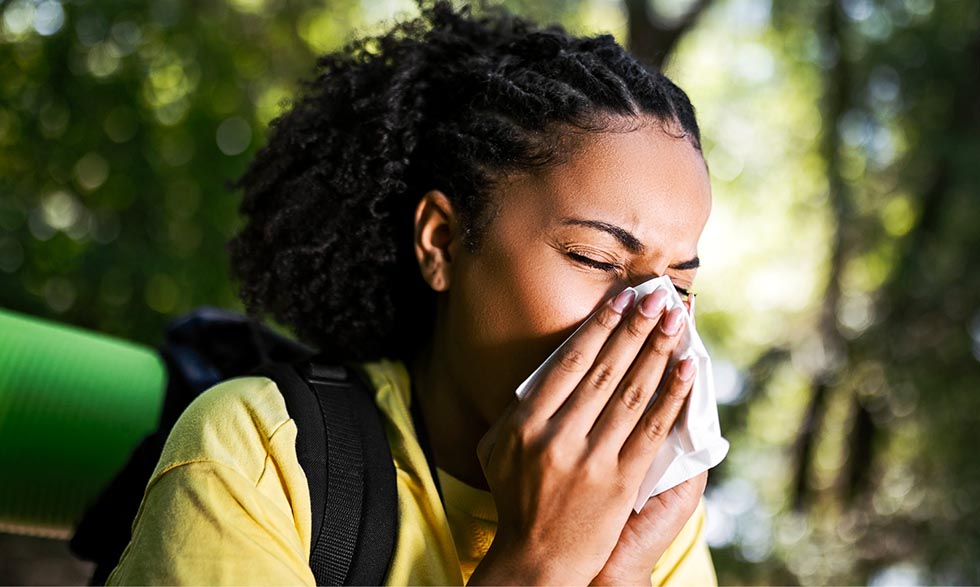Health Topics

What triggers seasonal allergies?
Trees, weeds, and grasses are often to blame
Ah, spring! It's the time of year when the cold goes away, sunshine warms your skin, trees and flowers blossom, and…your nose starts running, your eyes water, and you can’t stop sneezing.
If this sounds familiar, you’re not alone—seasonal allergies affect millions of people. If you’re one of them, those pretty trees and plants may make you feel worse, not better.
That's because of pollen, a powdery substance made by certain plants.
Pollen is harmless, but if you have seasonal allergies, your body mistakes the pollen for something dangerous. This reaction causes symptoms like coughing, sneezing, a runny or stuffy nose, and itchy, watery eyes. You might even feel like you have a cold.
Diagnosing seasonal allergies
If you experience symptoms only at certain times of year, you may have a seasonal allergy. For example:
- Tree pollen (especially from birches, oaks, elms, and maples) typically appears in spring.
- Grasses usually shed pollen in late spring and summer.
- Ragweed, a plant that many people are allergic to, produces pollen from late summer through fall.
- Mold spores can cause seasonal allergies during the spring, summer, and fall. They may also cause year-round allergies for people who live in buildings with too much moisture.
Unlike colds, seasonal allergies usually last longer than a week or two. If you have allergy symptoms and are looking for relief, check with your health care provider. Knowing the specific cause of your allergies can help you prevent exposure and treat your reactions. Often, a skin test or allergen-specific blood test can help confirm which type of pollen you’re allergic to.
All in the family
Seasonal allergies often run in families. If your parents or siblings have allergies, you’re more likely to have them.
Many people with seasonal allergies also have asthma. Pollen can trigger asthma, causing symptoms such as shortness of breath, wheezing, and coughing.
Easing your symptoms
Although it’s difficult to predict how bad an allergy season will be, paying attention to pollen counts in your area can help. Visit the National Allergy Bureau to find a local monitoring station or check your local news station for pollen counts in your area. Many weather websites and apps also include pollen forecasts. When pollen counts are high, try to stay indoors as much as possible.
Some medications work best when you start taking them before symptoms start. If you’re taking medication for your allergies, checking pollen counts can help you time your first dose and control your symptoms.
Here are some other useful tips:
- Save outdoor activities for late afternoon. Pollen levels tend to dip when the sun goes down.
- Mask up. A face mask can help block pollen when you’re outdoors. N95 masks offer the highest levels of protection.
- Keep your windows closed. While it’s nice to air out your home in the spring, avoid doing so when pollen counts are high.
- Shield your eyes. Wraparound glasses can keep pollen out of your eyes.
- Mow it down. Keeping your grass cut short can help reduce pollen. Mowing can also stir up pollen, so don’t forget to wear a mask and eye protection!
- Rinse off. Showering and changing clothes after being outside removes pollen from your skin and hair.
- Pet patrol. Brush off your furry friends after they’ve been outdoors to stop allergens from coming inside with them.
Medication and other treatments
Your health care provider may suggest saline rinses to ease nasal congestion or antihistamines to relieve a runny nose, sneezing, and itchy eyes. Some antihistamines include decongestants, which can reduce congestion, but those medicines are not for everyone. Your provider may also suggest a nasal steroid spray.
For more serious cases, your health care provider may prescribe allergy shots. Over time, these injections can provide relief by reducing your immune system's reaction to a specific pollen or other allergen.
Weather watch and a changing climate
Warmer temperatures linked to climate change are extending pollen seasons, allowing plants like ragweed (a major allergy culprit) to produce more pollen for longer periods. Increased carbon dioxide levels, another consequence of climate change, may make pollen even more potent, which can cause stronger allergic reactions. Research also suggests that extreme weather events such as heat waves and even thunderstorms can trigger or worsen allergy symptoms.
While seasonal allergies can be frustrating, they can be managed. Get to know your triggers, take precautions, and get support from your health care provider so you can enjoy the season without the sniffles.
*This article was originally published in February 2022. It has been updated.







